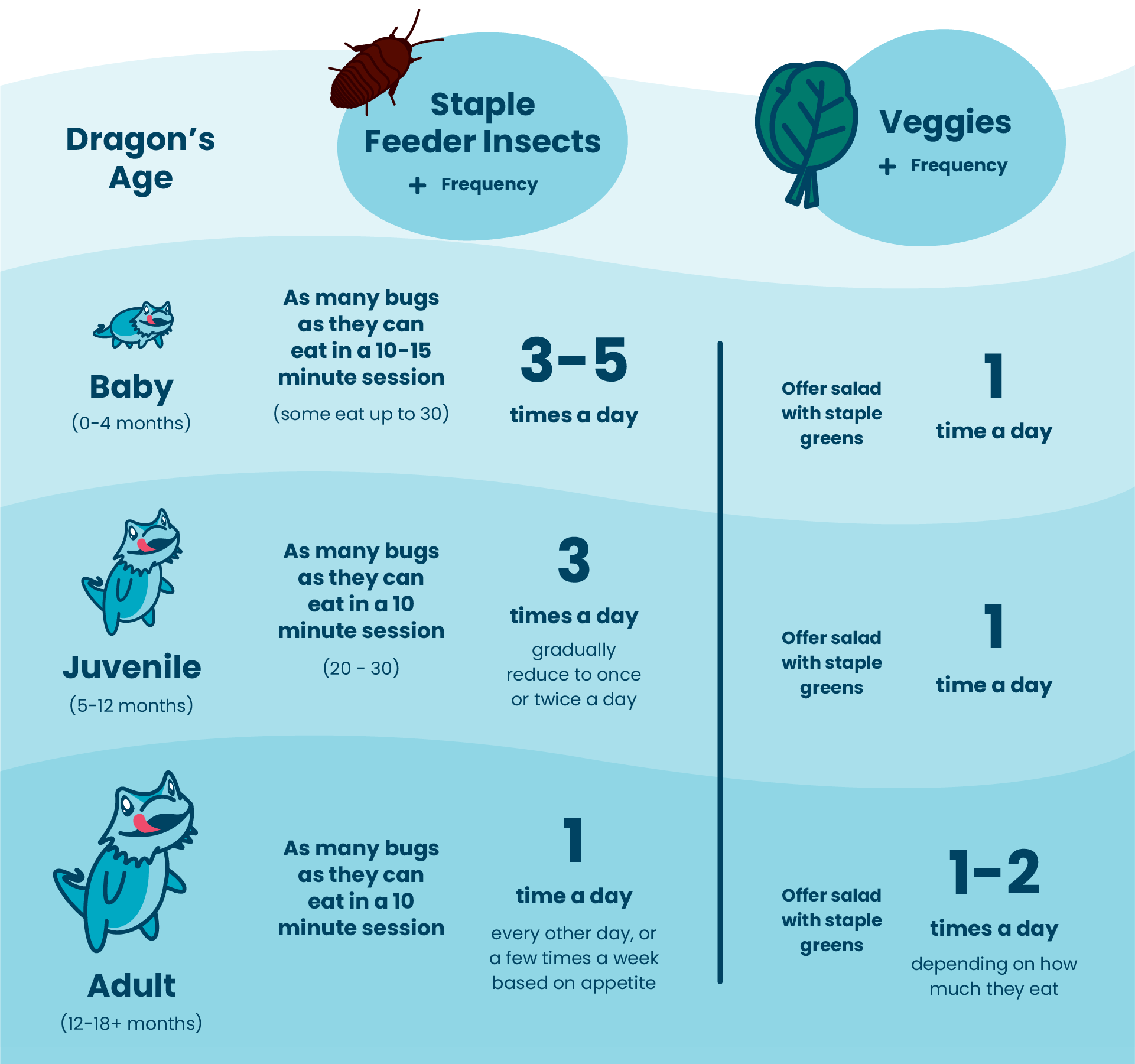Bearded dragons are carnivorous reptiles from the deserts of Australia. In the wild, they eat live insects and vegetables, with the occasional fruit or flower. But of course, it isn’t enough to know what to feed your bearded dragon if you don’t know how much and how often to feed him.
Our feeding chart will help you determine how often you should feed bearded dragons at different stages—baby, juvenile, and adult.
Bearded Dragon Feeding Chart by Age
Before we jump into our discussion, here is a bearded dragon feeding chart for quick reference.

You may have noticed there is no fruit on the chart. This is because you should only offer fruit once a week as a treat, regardless of your dragon's age. The amount of fruit may change as your dragon grows—for example, a baby dragon may eat one slice of strawberry while an adult might eat several pieces.
The same goes for supplemental insects that would be given as a treat, such as worms. They wouldn’t be daily staples but you can offer them occasionally.
How Often Do You Feed a Baby Bearded Dragon?
Baby bearded dragons need a lot of protein, so they will need to eat multiple times a day. Their diet should consist mostly of live bugs—lots and lots of live bugs. You may need to keep hundreds of feeders at a time to keep up with your baby’s appetite.
Baby bearded dragons will need greens and veggies as well as bugs, but at this young age when a baby is growing so much in a relatively short time, vegetables aren’t as important.
Wondering What Feeders to Give Your Baby Bearded Dragon?
Dubia roaches are excellent feeders for bearded dragons. They're packed with protein, they're easy to keep, and they're available in a size small enough for your dragon to eat safely. It’s hard to beat Dubia roaches as a feeder insect.
Crickets are also a good option, although there are some setbacks. They aren’t as easy to keep, they tend to smell bad, and they can intimidate baby dragons. If you want to use crickets, you may want to feed them one at a time so as not to overwhelm your dragon.

How Often Do Juvenile Bearded Dragons Eat?
Juvenile bearded dragons are in transition. They are not quite an adult yet but not a baby anymore. A significant amount of growth happens during this stage, which means they do still need a lot of protein, but at the same time veggies start to become more important in their diet.
During this time your dragon will go from eating 20% veggies around 4 or 5 months old to 80% by the time they are 12 to 18 months. That’s a big shift.
Every dragon is different, but this is the general time frame. So keep in mind that this is a gradual transition. You are going to be slowly offering fewer bugs and more greens.
Each month or every few weeks, depending on your dragon’s appetite, you can offer more veggies and less protein.
As your dragon grows, you can offer a little more fruit, but keep in mind that fruit will always be a treat, never a staple. It has too much sugar to be a staple.
Dealing with Loss of Appetite
It’s around this time that many dragon owners notice their pet start to experience a loss of appetite. Really what is happening is the juvenile dragon is struggling to adjust to all the greens. They're not used to it yet. This is normal, so don't worry (although if anything does seem to be a red flag, call your vet!). The best thing to do is to keep offering greens daily. Eventually, your dragon will adjust.
Pro Tip: To make greens more exciting for your dragon, you can hide roaches in her salad or top veggies with raspberries or another fruit.
How Often Do You Feed Adult Bearded Dragons?
An adult bearded dragon may only eat 8 to 10 Dubia roaches or feeders per serving. At most, adult bearded dragons eat insects once a day. Some are fine eating feeders just 3 times a week.
Adult bearded dragons can quickly become obese if they are overfed. They no longer need the same amount of protein as babies or juveniles; primarily they need nutrient-rich greens and veggies.
Appetite changes are quite common in adult bearded dragons. Stay informed about possible causes such as stress, shedding, or illness.
Feeding Tips for Your Bearded Dragon
Now that you know when to feed your bearded dragon, follow these tips to keep your dragon healthy and make the most of feeding time:
- Offer fresh water daily.
- Clean out any uneaten food at the end of each day.
- Feed your dragon live insects in a designated bin to avoid feeders escaping in the terrarium.
- Make sure all insects and pieces of fruit and veggies are no bigger than the space between your dragon’s eyes. This helps minimize a risk of choking or gut impaction.
- For optimal nutrition and to help prevent metabolic bone disease, dust insects with calcium powder. Put them in a baggie and shake it up before serving. You can also sprinkle calcium on your bearded dragon’s salads.
Got questions or feedback? We want to hear from you! Email us at team@dragonsdiet.com








